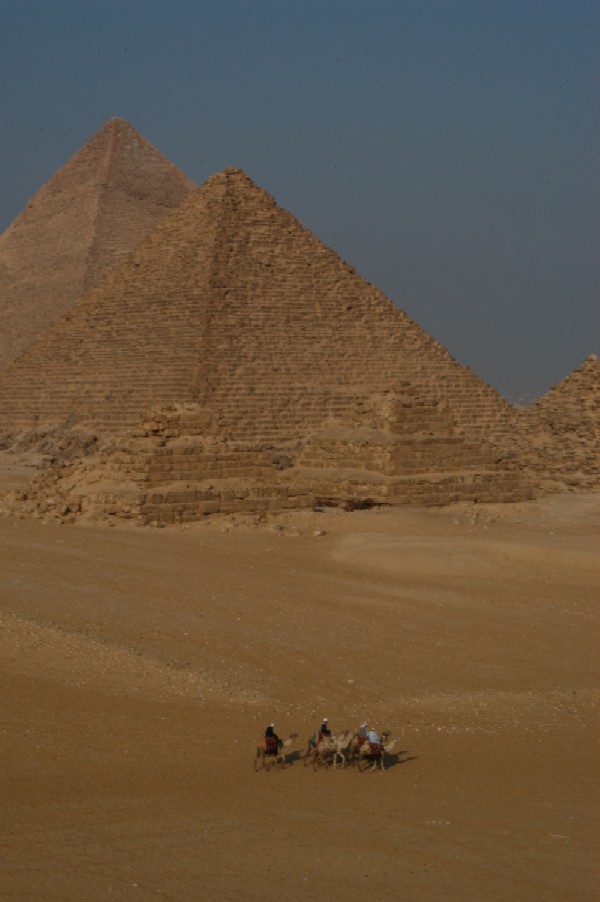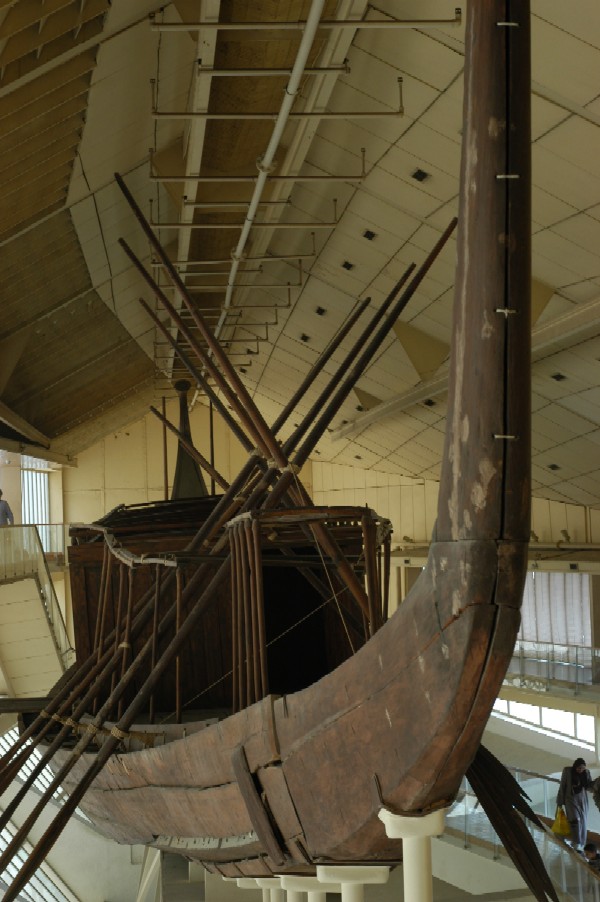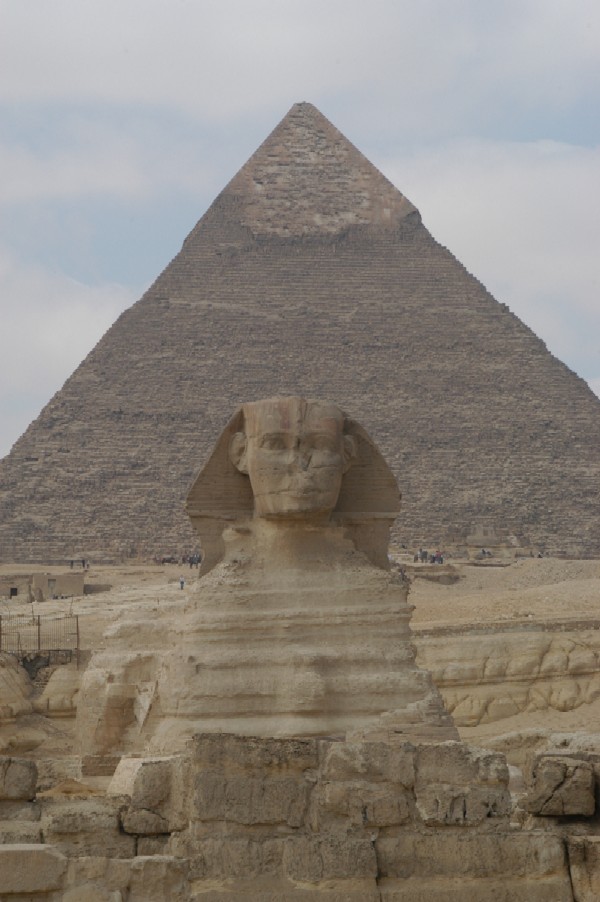February 7. CAIRO "The Pyramids at Giza" It was hard to sleep in very late when the muezzin beckoned for prayer at dawn so we got an early start to the pyramids after a promptly served breakfast of Turkish coffee and rolls with jam and cheese. The public bus station wasn't far from our hotel but involved a few death defying jaunts across streets. A man a the ticket window directed us to stand on the major street outside that station underneath the hisbis (HSBC) sign. There wasn't much of a place to stand under that sign but we squeezed onto the narrow triangle of pavement where the road split to the left or turned to loop around the traffic circle, a nerve-wracking location that made us feel like cars and buses were constantly about to fly directly into us. The bus numbers were written in Arabic so we had made an effort to memorize them before we set out in the morning and it was a quick test of our memories to make out the numbers as the buses flew past us. The buses only stopped if they were waived down so when we finally saw the right combination we waived frantically. When the bus door opened I made a triangle shape with my hands and said "pyramids?". The driver nodded and said "Giza". Arabic so we had made an effort to memorize them before we set out in the morning and it was a quick test of our memories to make out the numbers as the buses flew past us. The buses only stopped if they were waived down so when we finally saw the right combination we waived frantically. When the bus door opened I made a triangle shape with my hands and said "pyramids?". The driver nodded and said "Giza".
The traffic wasn't very heavy and we flew across town until the bus came to a final stop. The area looked like anywhere else in Cairo but plodding a bit farther up hill we rounded a bend and out of nowhere appeared the Great Pyramid of Cheops, Egypt's largest pyramid. The approach wasn't as dramatic as it could have been since we hadn't expected to just fall off of the edge of Cairo and practically land on a massive pyramid but it was still a thrill. A nondescript ticket booth sold us access to the pyramid grounds and the sphinx and after a cursory bag check we were standing right at the base of the mammoth tomb. We were on the shaded side of Cheops and in the distance we could see the Pyramid of Chephren, looking more imposing with its intact summit, and for a minute we thought we had them confused. But, Cheops was the indeed bigger only to have lost all of it's once smooth surface when people chipped away it's exterior to use the limestone.
A small area around the entrance to the pyramid had been cordoned off and people were climbing up a couple of levels to have their photo taken. We climbed up to the entrance and the guard "baksheeshed" us to take a photo at the gate. A French hippie was hassling them to get inside since the 150 allowed in the morning had already been expired and another 150 wouldn't be allowed in until the afternoon. Once we got past the hippie we weren't even impressed enough to take a photo since it was just a metal gate set in rock and it could have been anywhere. The guard got his dollar anyway.
We walked around the pyramid to the right until we came to the solar boat museum, an elongated and rather unsightly structure elevated from the ground. They were charging for a video camera so I went in to investigate on my own. The reconstructed 43-meter long boat was elevated and surrounded on all sides by a walk way. It was a simple boat to look at, one of five found around the pyramid, the purpose as of yet unknown. The amazing thing about it was that the wood had survived for so many millennia and they were able to reconstruct the boat from the 1200 pieces found in one of the boat pits.
From Cheops we made our way down hill towards the Sphinx. To the west loomed the fringe of Cairo and to the  east was the vast desert landscape. In between the great monuments were scores of tourists and every ready camel men eager to interest you in a ride, not to mention the occasional scam artist that tried to lure you into an unwanted tour by just spontaneously starting to guide you so he could hit you up for money later. It was hard to go more than twenty feet without being approached by someone. It all had a slight dampening effect on the grandeur of these incredible human accomplishments. east was the vast desert landscape. In between the great monuments were scores of tourists and every ready camel men eager to interest you in a ride, not to mention the occasional scam artist that tried to lure you into an unwanted tour by just spontaneously starting to guide you so he could hit you up for money later. It was hard to go more than twenty feet without being approached by someone. It all had a slight dampening effect on the grandeur of these incredible human accomplishments.
The Sphinx stood facing Cairo at the foot of the hill beneath the pyramids. Beyond Chephren stood the smaller Pyramid of Mycerinus, creating a row of three pyramids in diminishing sized lined up behind the Sphinx. Six smaller pyramids, in two rows of three. were on either end of the larger ones - these were the queens' pyramids. With our backs to Cairo the view of the Sphinx with the pyramid and desert backdrop was a classic vision of ancient Egypt and the one we had been expecting, even if the Sphinx came out smaller than imagined. The tour groups were in full swing at this point and were huddling to the one side of the Sphinx where people were allowed to approach. We sat for a while to get views in the company of a smaller crowd but never had a truly serene moment.
Facing towards Cairo the sight that we immediately noticed, embedded in the lack luster collection of rundown buildings was a three story Pizza Hut/KFC. The bright red signage stood out like a sore thumb but as it promised the best lunch view of the pyramids available we gave in and had chicken sandwiches as we stared out across the vast landscape. But there was something about a fast food chain next to ancient monuments that drew a vivid contrast between antiquity and modern society. Indeed, Cairo's mass of civilization butted up against the pyramids was a comparison in the achievements of two worlds that existed millennia apart.
After lunch we dodged some taxi touts to get back into the pyramid grounds and hiked up the hill to line up for tickets to see the Great Pyramid of Cheops. More camel men tried to solicit us for rides. When we said "no" they always followed up with "later?" as they trotted along behind us. The line for Cheops had already gotten long by the time we arrived but since they only allowed one person to buy a single ticket we were still within the 150 person limit for the afternoon. (No doubt the $18/person fee was a limiting factor for many visitors.) We waited for a half hour while the bulk of the people took their turn. We couldn't enter with cameras so Rob and I each went in separately. I went first and found the first part of the tunnel empty. About seventy-five feet inside the tunnel met an 1:2 incline through a lower and narrower corridor (only 1.6 meters high). A group of people were coming down as I went up. We were all crouched down over our legs awkwardly stepping from one wooden slat on the ramp to the next. Getting past one another was a squeeze and by the time I was through the 100 foot ascent I was working up a good sweat. The ascent corridor opened out onto the Great Gallery , a narrow hall that sloped upward with a ceiling over 25 feet high. Directly ahead of me was an even smaller opening that led to lower and narrowed corridor, definitely crawling territory, to a small chamber but the gate was closed. I climbed around the sides of this entrance to continue my ascent up the Great Gallery. There was no one else in there and the solitary feeling was eerie. I could hear voices ahead and after working up a greater sweat to reach the top of the 140 foot long Great Gallery I encountered another low doorway. About six feel along it opened up into a taller chamber and then quickly lowered again for about another six feet until I finally came to King's Chamber. was working up a good sweat. The ascent corridor opened out onto the Great Gallery , a narrow hall that sloped upward with a ceiling over 25 feet high. Directly ahead of me was an even smaller opening that led to lower and narrowed corridor, definitely crawling territory, to a small chamber but the gate was closed. I climbed around the sides of this entrance to continue my ascent up the Great Gallery. There was no one else in there and the solitary feeling was eerie. I could hear voices ahead and after working up a greater sweat to reach the top of the 140 foot long Great Gallery I encountered another low doorway. About six feel along it opened up into a taller chamber and then quickly lowered again for about another six feet until I finally came to King's Chamber.
The King's Chamber lies about 300 feet below the apex of the pyramid and measured about 15 feet wide, 18 feet long and 30 feet high. A hand full of people were sitting around catching their breaths. A couple of people were in a meditating position and I saw the French hippie from earlier in the day setting himself up for a long stay, isolating himself behind the lidless sarcophagus that stood at the far end of the chamber. The thought of the immense amount of weight and pressure that was being exerted on this small space sent chills up my spine. The pyramid was built around 2589 to 2566 BC and originally stood about 480 feet high but with the loss of some of its exterior it is estimated to be about 10 feet shorter. The base stands about 700 feet long and the total estimated weight is about six million tons, a large part of which was now layered above my head. It was a mind boggling accomplishment for a civilization some 4500 years ago. But, aside from the awesome feeling of being inside this amazing structure there was very little to look at since the walls weren't painted or carved. I didn't linger a very long time before descending back out to the fresh air, my steps echoing against the stone walls. When I came out of the small corridor I met an Egyptian family with a small boy. The young wife was dressed in black with just her face showing. I smiled at her as I walked past and she smiled back but began to look slightly nervous after a few seconds, as though she were worried that I might say something.
Rob took longer with his exploration of the pyramid while I cooled off. By the time he returned it was approaching three o'clock and the crowds of people had thinned out somewhat so we walked past the row of pyramids to view them from smallest to shortest. Our walk took us over to a hill amongst the sand dunes beyond the  last pyramid. From our viewpoint they looked squashed up against each other with the mass of Cairo sprawled out behind them as a back drop. When the afternoon prayer call came the city hummed with Allahu Akbar ("God is most Great") and then softly quieted again. A few tourists were playing Lawrence of Arabia on rented camels as they putted around the pyramids on the "ship of the desert". It was serene and impressive. last pyramid. From our viewpoint they looked squashed up against each other with the mass of Cairo sprawled out behind them as a back drop. When the afternoon prayer call came the city hummed with Allahu Akbar ("God is most Great") and then softly quieted again. A few tourists were playing Lawrence of Arabia on rented camels as they putted around the pyramids on the "ship of the desert". It was serene and impressive.
Walking back to the bus stop it struck me that, aside from the handful of people hawking drinks or some postcards out of buckets or satchels and an eager population of camel men trying to sell rides, there had been no other concessions inside the pyramid grounds. There wasn't even a small gift shop aside from the one inside the boat museum. They had kept the tourism kitsch away. However, just to the north west of the pyramids they were constructing a large stadium that, once finished, would make the great pyramids look even more like a Cairo sideshow. One had to wonder if in another ten or twenty years the pyramid grounds would be little more than a city park within Cairo.
It had been a long day but we were both keen to have another dinner in Khan el-Khalili so we only took a brief stop at our hotel after we got off of the bus before we grabbed a taxi into the Islamic area and indulged in another hearty meal of kebabs, tahini, baba ganough, and salad. We finished off the day sitting at Fishawi's watching people over an overpriced couple of mint teas. |

